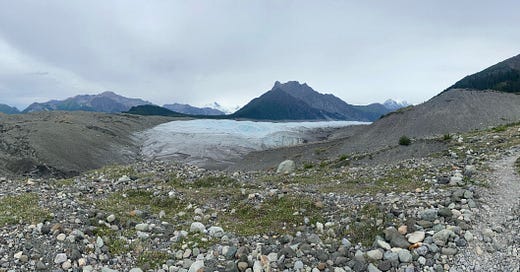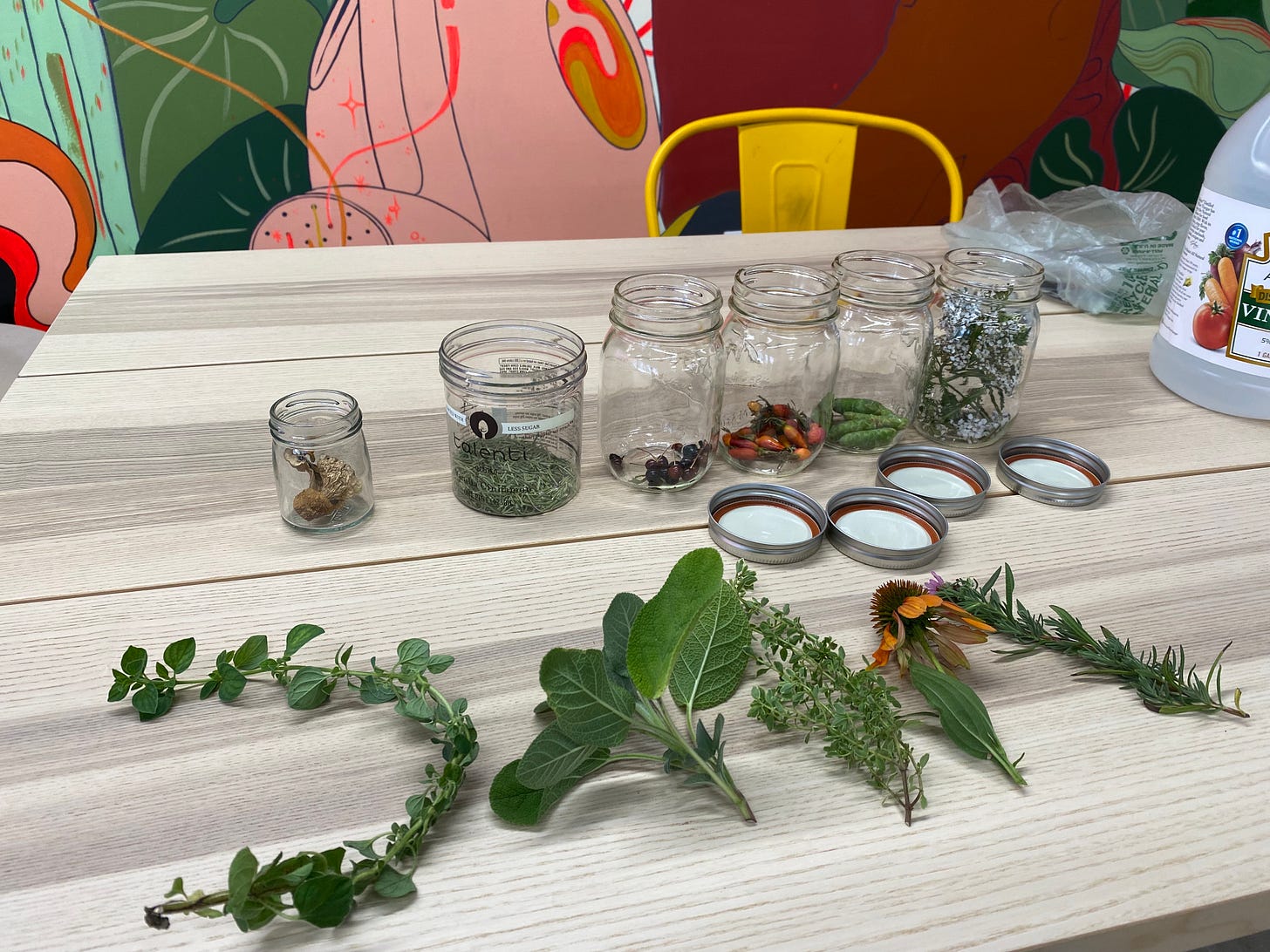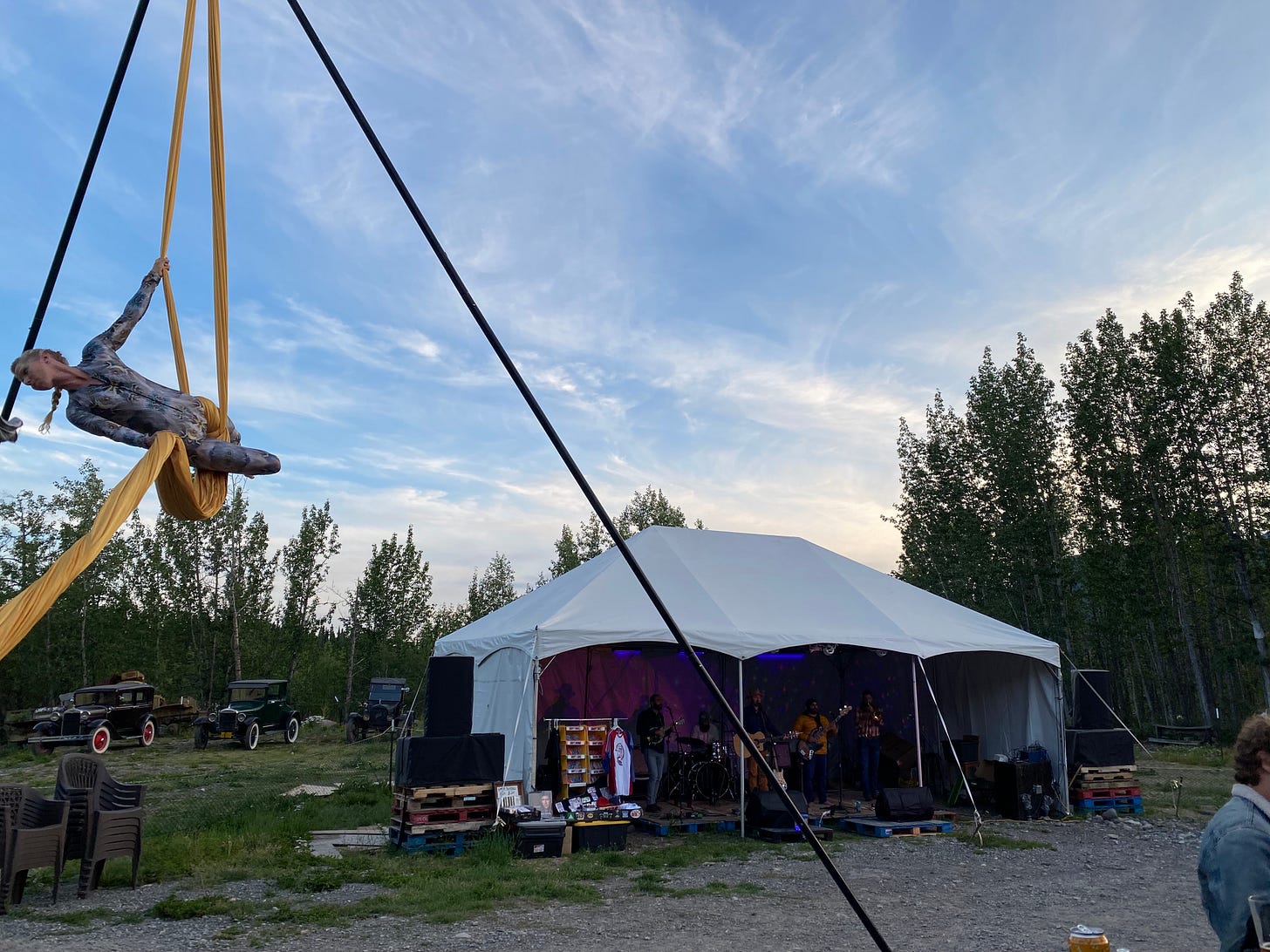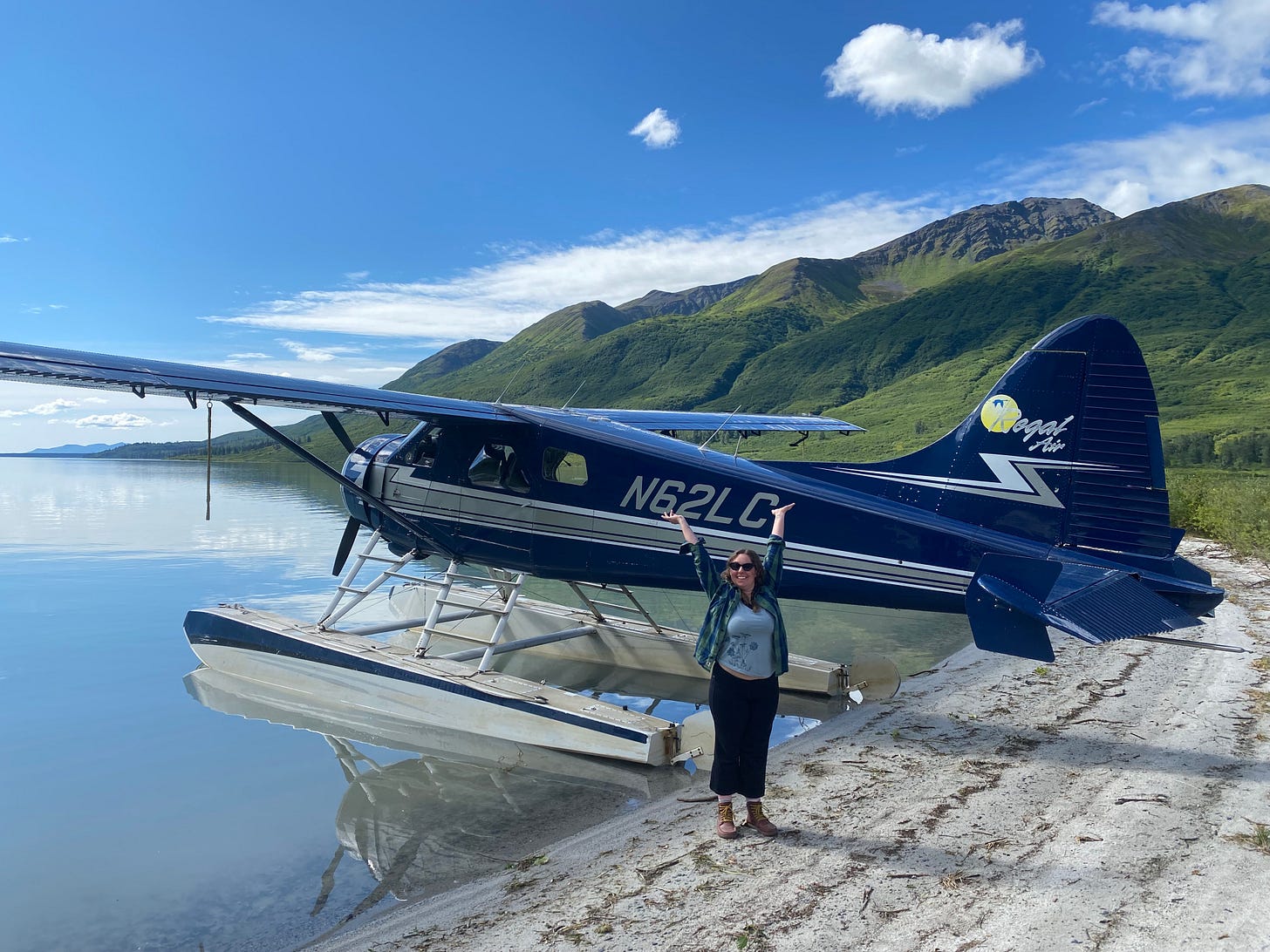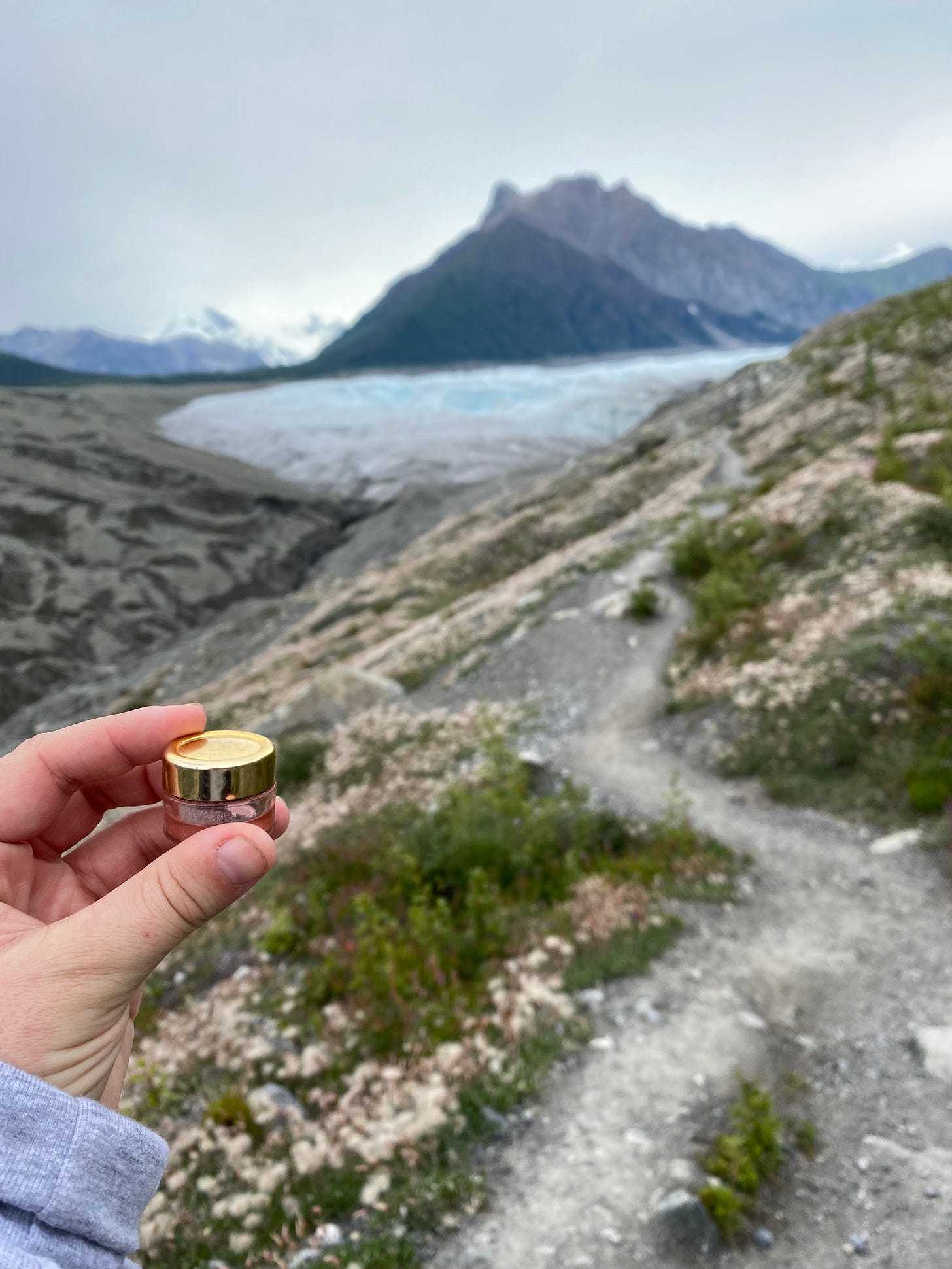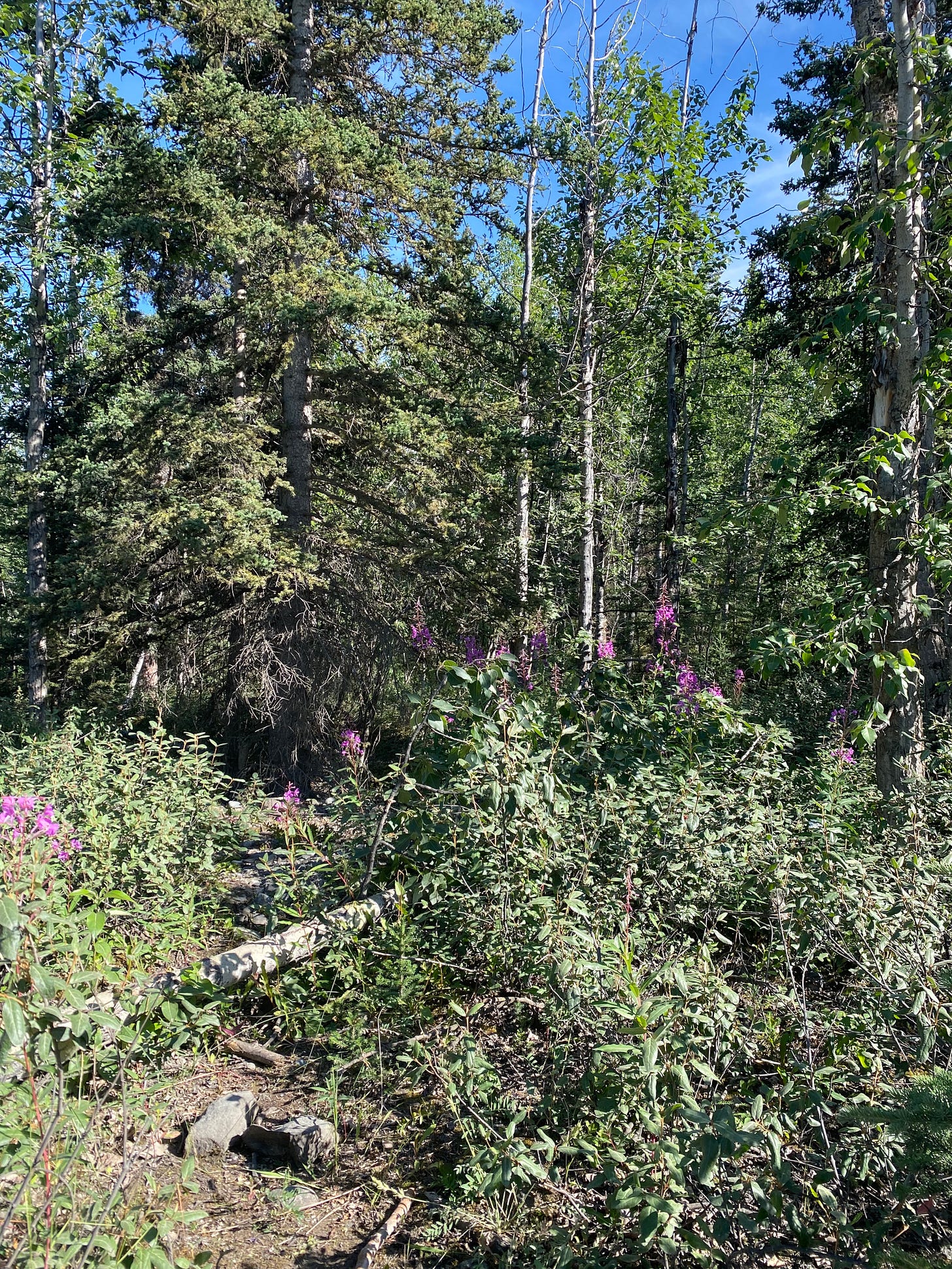(Read to the end for my book tour announcement!)
This is the free version of my newsletter. If you want to support my writing, please consider a paid subscription for yourself or a gift subscription for a friend.
You can also join me on Patreon, where you get the same benefits as my paid subscribers here.
If you can't afford the paid newsletter, but it would be an asset to you in your own culinary/writing/creative journey, please reach out and we'll figure something out!
In Alaska, I was struck by a sense of novelty and of familiarity, operating in tandem but not in tension. I found commonalities between the many mountains I’ve loved, either as a visitor or nearby resident.
Some little peaks, like witches' hats tucked into the front of a range, reminded me of Diamond Hill in Letterfrack, Ireland. I walked trails in spaces that felt expansive, almost empty of human-made structures, but also with greenery pressing in to the footpath, tickling your legs, a familiar feeling from walks in the Scottish Highlands. I found similarities, too, to the clear water and waterside cliffs in Thailand's Khao Sok Forest, wanders up little French village streets, and even a whisper of the cliffs in Cappadocia, more in color and the suggestion of shapes carved out than of the fairy towers and pigeonholes themselves.
I have a tendency to draw these connections when I travel: if you've been reading my work for a while, you probably recognize that interconnection and overlap are a big part of my perspective. But novelty is, too, and Alaska gave me the opportunity to dive into both and to reconnect with some ideas about food and resourcefulness that I hold dear.
Home and away
While the Alaskan landscapes I visited gave me glimpses into old travel memories, the place it reminds me of most, in spirit and sometimes also in the shape of hills or density of forests, is the southern Appalachians. In both places, I'm more likely to encounter someone who hunts, forages, preserves, or gardens than I am in many other places I've spent my time, but there's also a similar perspective on the world.
I feel like there's a sense of grounding within place: an appreciation for the wonder of the place itself, a sense of community and solidarity I sometimes find lacking in large cities, and a (very understandable) distrust of outsiders, who have a history of visiting purely to extract resources or who, at the very least, perhaps don't realize the full extent of the magic such places have to offer.
Here, as far from my home as you can get while staying in North America, I was struck by how homey everything felt: The familiar feeling of creating community and comfort in a place that doesn't just hand comfort to you. To find comfort here, you have to seek it out and create it: An act of manifestation many of us rarely experience.
I can't pretend to be an expert on Alaska, but I was struck by a particular dichotomy that came up over and over in conversations, and that I'm eager to explore when I go back again next year.
I came to Alaska to share what I've learned about place-based food storytelling: That is, using local and wild ingredients and wild fermentation to capture the flavor of a place and time. But I also came to learn, both about food and plants (like fireweed, a new favorite) found here and about the people I met.
Over and over, I talked with people in the town of McCarthy and at the Anchorage Museum SEED Lab about various food production and distribution in the state. One thing we all noted was an incredible closeness to the land and an awareness of the abundance of food sources it offers, alongside a heavy dependence on supplies from outside.
Rebecca Pottenbaum, the genius mind behind the Lab's programming, said it especially well, noting that roughly 92% of all food in Alaska is shipped in from somewhere else: If shipping traffic to Anchorage was disrupted, there would be about a week's worth of groceries on the shelves.
A goal of my workshops is to offer an appreciation for working with wild foods, for using up scraps, and for harnessing the power of local and wild ingredients and wild fermentation to connect us to place. Here, it was more about deepening existing connections, rather than helping people develop them in the first place.
In McCarthy, for example, many people live in dry cabins, and it would be utterly ludicrous of me to come in and say "I'm going to help you appreciate nature!" to a person who hauls their own wood and water every day. Instead, we learned from each other: Everyone sharing what they know, appreciating each other's company, and engaging in learning as a community act rather than a one-way transfer of information. It was a wonderful combination of conversation and inspiration with hands-on time with plants in the forest and food in the kitchen.
Taking the long view
Living in a place where many people can gather their own wild foods, while also relying on imported resources, requires you to take a long view when it comes to food.
In a place where so much is shipped in, you’re keenly aware of the resources you use: asking for an extra handful of napkins at a restaurant means a handful fewer for the future until a new box of them arrives. In areas where you rely on mail planes or many-hours-long supply runs, careful planning and resource use is essential: If I run out of gas when I'm 5 hours from a gas station, or run out of important pantry staples, it's no small feat to get more.
But Alaska is not some desolate place only made habitable by modern shipping infrastructure: People have lived here for thousands of years, and not only lived but thrived, and this history of reliance on the seasonal bounty of the landscape, and the importance of food preservation, were front of mind for many people I spoke with.
In my writing, I often talk about principles of seasonality and of an approach that honors abundance on one hand and awareness on the other. Abundance, in that we appreciate the natural gifts we work with and use them to their greatest extent. Awareness, in that we understand resource limits and practice restraint.
In other words, celebrating and indulging in the abundance of the current moment, while being discerning in a way that allows us to do so in the future, too. It's the way humans have lived through most of our history, and a way many of us might not remember.
The Alaskan landscape drives this point home, because unlike many other parts of the U.S., there are large swaths that have been minimally developed or are minimally inhabited by people. This puts the place, not people, at center stage, and decentralizes us from that narrative. There's an understanding, in other words, that the real driving force here is the natural environment, rather than the belief that humans are running the show.
I felt my humanity more fully by being put in context of the natural world in inescapable ways. By being one small part of a large landscape, I was given space to expand and be myself.
I wonder how we might apply this practice to our lives in the lower 48: if we recognize that use means what it says, that we are using a resource, how might our habits shift? So much is shipped to Alaska but in truth, so much is shipped in to other places too. How much better off would your, or my, town be if we were cut off from our supply routes?
It does not mean cultivating a scarcity mindset or motivating our actions out of fear, but rather is an acknowledgment that our actions have consequences, and that the earth is asking us to make considered choices rather than just assuming limitless consumption. In other words, practicing gratitude for our current abundance and making choices with intention.
News
My latest book, Our Fermented Lives, comes out this month!!!!
If you've been waiting for your copy, they'll begin shipping them out on September 27th (and in November if you're overseas).
If you have been waiting to order one, now's the time! Preorders have a huge impact on the success of a book and on authors' livelihoods (and I'm happy to sign it on my book tour!)
Speaking of book tours:
I'll be touring the Northeast this fall, with plans for other stops next year.
To kick things off, I'll be speaking at Decatur Book Festival on October 1st. It's free, and I would love to see you there!
D.C.: I’ll be at Bold Fork Books on 10/5
NYC: I’ll be at Archestratus on 10/9
Other stop(s) TBA!
Keep an eye on this page or on my social media (@rootkitchens and @bookishjulia) for my latest tour schedule!
Other events:
Atlanta: Please mark your calendars for October 22nd!
I'll be having a big Our Fermented Lives book party here in Atlanta with Chef Edward Lee that includes:
A screening of his film Fermented
A Q+A about fermentation with Edward and myself
A kombucha mocktail based on the book
And of course books available for sale through our friends at Charis Books.
I'm also hoping to collect optional donations for Umi Feeds and the LEE Initiative
There will be food, drink, and general merriment: Please come celebrate with me!
Other places you'll find me this fall:
Please come see my ferments as part of the exhibit Oneness That Is, Too, where they’re in multispecies conversation with work from other Atlanta artists. Learn more on the Art Papers website.
As a speaker at Atlanta Fermentation Festival on November 6th
As a speaker at the Chicago Brewseum's Beer Culture Summit on November 10th
To Read/Listen
This episode of Japan Eats! features an interview with Yuichiro Murai, the 29th generation of a koji merchant family based in Aichi Prefecture.
This helpful list of food writing resources from Priya Krishna.
For Alaskan friends, the Cordova Fungus Festival comes highly recommended. It happened earlier this month, but happens yearly. For those new to Alaska, this glossaryhelps you understand glacier terms. And speaking of glaciers, Rose McAdoo's interview remains a favorite from the Unplated series.
Heather Wall's newsletter is full of fascinating dives into the natural world, like this piece on why writing spiders write.
Her interview for the Unplated series will be out soon!This year, I’m inviting readers to join me in brief vision journaling exercises each month to help us intentionally craft a meaningful and hopefully joyful 2022. You can learn more and see the year’s prompts here.
This month’s journaling prompt is:
How do I want people to connect with my work? What do I want them to take away? What accolades, social following, fame, expertise, etc feel meaningful to me?
To Make: Five Spice Winter Squash Syrup
My answer to baking spice-based syrups (yes, like pumpkin spice, but also cinnamon apple and other flavor profiles), I love to use warming five spice powder and find this syrup is great for just about any sweet application I throw at it. If you’re a wintertime baked brie sort of person, this syrup works well drizzled on top of that, too.
You can use any kind of winter squash you prefer: So far I’ve tried candy roaster, butternut, acorn, and pumpkin.
Five Spice Powder
½ c whole star anise
1/3 c Sichuan peppercorns
2 tbsp fennel seeds
3 sticks cinnamon
1 tbsp whole cloves
-Lightly toast whole spices in a pan until fragrant (stirring or tossing constantly to keep from burning).
-Allow to cool and pour into a mortar and grind with a pestle (or use a coffee grinder reserved for the purpose of grinding spices)
-Store in an airtight container
Spiced Squash Syrup
Note: For a different, but also delicious take, use Alicia Kennedy x Burlap and Barrel’s pumpkin spice blend
Winter squash, any variety
Five spice powder
1 c brown sugar
1 c white sugar
2 c water
pinch salt
1 tsp vanilla extract (optional)
-Preheat oven to 350 degrees F
-Half your squash and remove the seeds.
-Liberally sprinkle the inside of your squash with five spice powder
-Bake until very tender, remove from oven, and allow to cool.
-Peel your squash and place the flesh in a saucepan.
-Add your sugars, salt, and water to the pan and cook until sugars are completely dissolved. Add more spice blend (if desired) to taste
-Cook your syrup down until the flavor is as strong as you’d like: The longer you cook, the more intensified the squash and spice flavors will be. I usually cook mine for about 10-15 minutes.
-Remove from heat and add vanilla extract, if using
-Strain syrup through a fine mesh sieve and store in the refrigerator.
This is the free version of my newsletter. If you want to support my writing, please consider a paid subscription for yourself or a gift subscription for a friend.
You can also support my work on Patreon, starting at $1/month.
If you can't afford the paid newsletter, but it would be an asset to you in your own culinary/writing/creative journey, please reach out and we'll figure something out!


